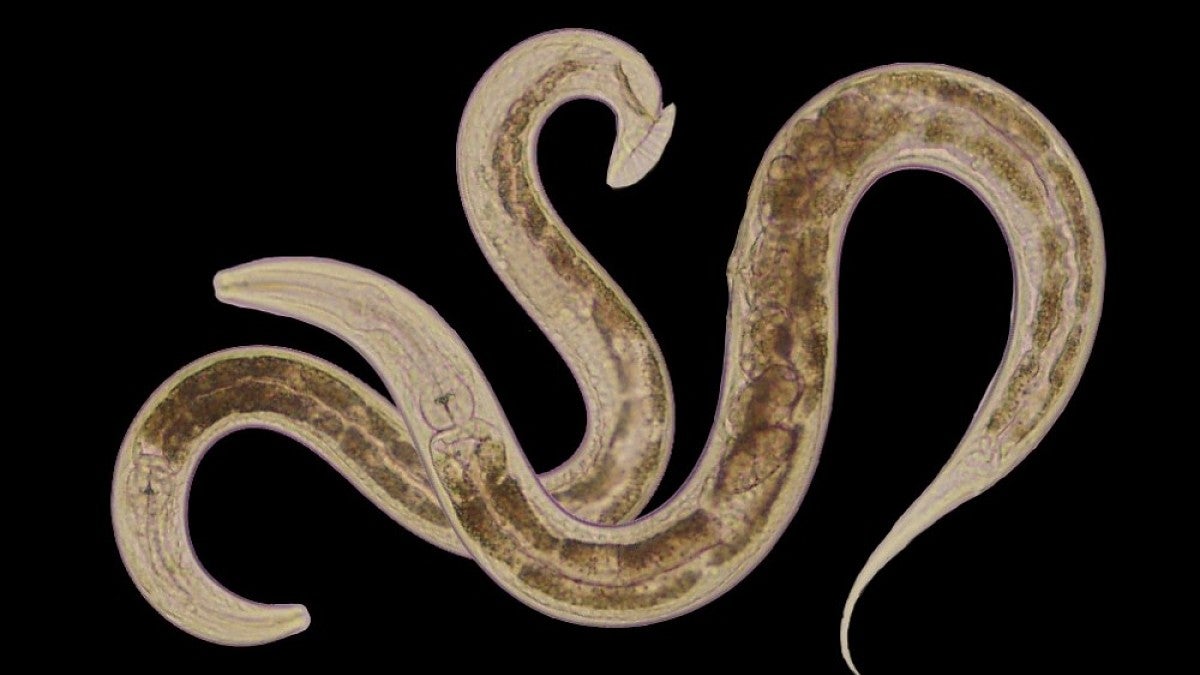EUGENE, Ore. — (May 28, 2015) — Men and women often enter relationships with different long-term goals. In the animal world, differences in approaches to reproductive success can lead to sexual conflict.
Male fruit flies, for example, transfer proteins during mating that can alter the timing of a female’s egg laying and her tendency to later mate with other males. Some of these male-derived proteins also migrate from the female’s reproductive tract to her brain.
Now, a new study from the University of Oregon and Bowdoin College shows that sexual conflicts can evolve rapidly in natural populations, driven by competition among males for mating success. The study was published online this month in BioMed Central's open-access journal BMC Evolutionary Biology.
Researchers in the UO lab of Patrick C. Phillips, a professor of biology, had just begun a set of experiments using the tiny nematode Caenorhabditis remanei, when graduate student Colin Peden noticed that females that mated with males originally collected from New York tended to die quickly in comparison to those that mated to males from Ohio or Germany.
Peden found that females mated to New York males for even a single day lived only half as long as they did spending their lives as virgins. Even when they lived, females mated to New York males produced half as many offspring as when their offspring were fathered by other males.
Phillips and colleagues then asked, in an evolutionary sense, how could the attributes of the New York males still exist when they lead to so few successful offspring in the next generation?
In seeking an answer, they put the different males together in a competition. The sperm of the New York males, the researchers found, easily outcompeted sperm from the Ohio and German males to successfully fertilize a female’s eggs.
“Despite their small size, nematode sperm is actually much larger than human sperm, and it is thought that the sperm from different males literally battle it out inside the female for access to her eggs,” said Phillips, who is a researcher in the UO's Institute of Ecology & Evolution. “So a reasonable evolutionary explanation would be that these males make bad mates but highly successful fathers.”
To test this hypothesis more rigorously, Phillips turned to Michael Palopoli, an evolutionary biologist at Bowdoin College in Brunswick, Maine.
Palopoli and a group of undergraduate students used genetic tricks to transform the mating system of a closely related nematode Caenorhabditis elegans.
These roundworms usually exist as hermaphrodites that reproduce using sperm and eggs produced inside the same individual. Males also exist in C. elegans, but they are rare and wimpy compared to males from male-female species like C. remanei. Palopoli and his team used a genetic mutation that blocks sperm production in hermaphrodites, effectively turning them into females. They then mated these newly formed females with males and allowed them to evolve together for 60 generations.
Males in this highly competitive environment rapidly evolved larger sperm, as well as sperm that became much more competitive when compared to their female-free ancestors. Most importantly for the evolutionary story, these males also evolved such that females died more frequently when mated with them than when they were mated with males that had never been subjected to the high male-competition treatment.
“Overall, we were able to rapidly recapitulate the evolutionary pattern that we see in the male-female species by converting a hermaphroditic species to be male-female and then allowing them to evolve under these new circumstances,” Palopoli said.
The mystery of why sexual conflict exists within these species is now replaced by the mystery of how the males are affecting the females. “It could be a change in the behavior of the males, or it could be something in the seminal fluid that they transfer during mating,” Phillips said. “We are following up on this work to figure that out.”
The National Science Foundation supported the research by grants (DEB-064-1066 and DEB-1120417) to Phillips. Additional funding was provided by the National Center for Research Resources (5P20RR016463-12), the National Institute of General Medical Sciences of the National Institutes of Health (8P20GM103423-12), the Howard Hughes Medical Institute's Undergraduate Science Program and Bowdoin College.
Coauthors with Phillips, Peden and Palopoli were Caitlin Woo and Ken Akiha of Bowdoin College. Other UO coauthors were Lori Cruze, a former UO research assistant now a professor in the Department of Obstetrics and Gynecology at the Medical University of South Carolina; former UO undergraduate student Megan Ary, now a mathematics teacher in the South Lane School District in Cottage Grove, Oregon; and former research assistant Jennifer L. Anderson, now a researcher at the National Institute of Agronomic Research in Rennes, France.
Media contact: Jim Barlow, director of science and research communications, 541-346-3481, jebarlow@uoregon.edu
Sources: Patrick C. Phillips, UO professor of biology, currently on sabbatical at the Ecole Normale Superieure in Paris, pphil@uoregon.edu, and Michael F. Palopoli, professor of evolutionary biology, Bowdoin College, 207-725-3657, mpalopol@bowdoin.edu


